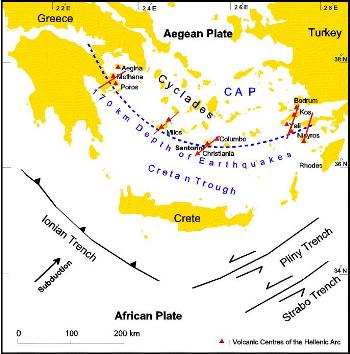
It’s peaceful running here. Beside the road, straggly vines drape across the ground, Santorini-style. I trot past a cluster of pines, round a corner, and a vista opens. Beyond the airport to my left, the horizon rises evenly through sparse brown fields. The white town of Pyrgos stands atop the hillside, looking out to Fira on the crater rim, and the tourist trail to Oia. Nothing is flying yet, though a few cars drift past, carrying holiday workers to their travel agencies and hotels. Ten minutes go by as the day grows warmer and my legs steadily measure out the long road beside the runway.
The church of Agios Ioannis (St John) lies up ahead. Not far beyond lies the pretty beach of Monolithos, with Vourvoulos hidden further on. Quiet, dreamy hideaways these, floating in the forgotten corners of a tourist island — yet still recalling the violent history of this place. Because this landscape, between Ancient Thera, Pyrgos and Monolithos, formed around a smaller, older island that was buried by a series of cataclysmic eruptions throughout the past 200,000 years.
The road to Vourvoulos cuts through cross-bedded volcaniclastics, stuffed with vicious-looking volcanic bombs, each more than big enough to kill a man. Dating from an early eruption, these rocks fell long before recorded human history. The main event occurred 40,000 years later, around 1645BC, when the Minoan civilisation ruled the eastern Mediterranean. But their archaeological record is scant, perhaps consistent with the geological catastrophe that destroyed their power.